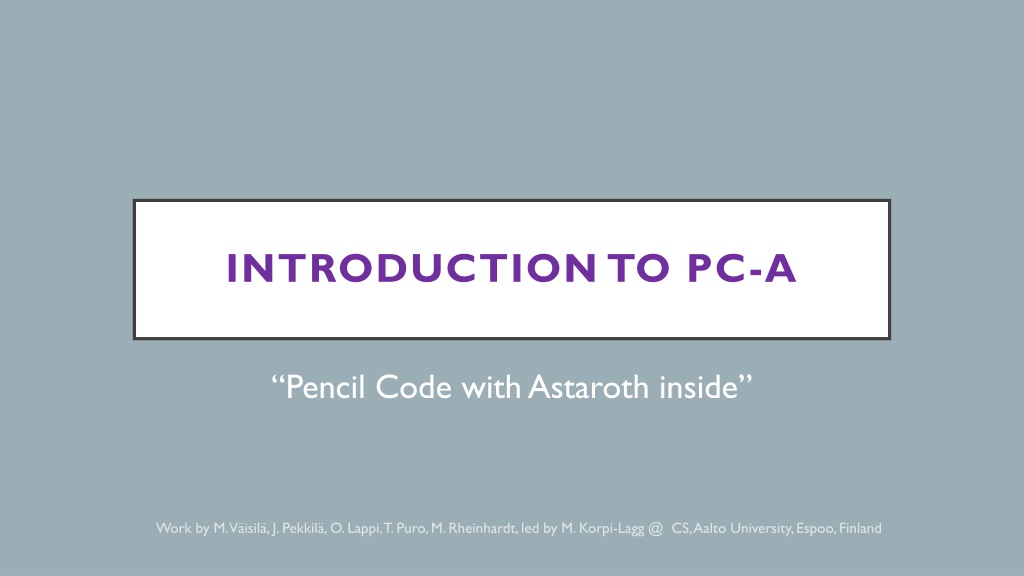
PC-A Pencil Code Guide: Building, Setup, and Usage
Discover how to effectively utilize PC-A Pencil Code with Astaroth inside, including mindset considerations, code retrieval instructions, cluster building advice, and DSL code insights for efficient computational tasks.
Download Presentation

Please find below an Image/Link to download the presentation.
The content on the website is provided AS IS for your information and personal use only. It may not be sold, licensed, or shared on other websites without obtaining consent from the author. If you encounter any issues during the download, it is possible that the publisher has removed the file from their server.
You are allowed to download the files provided on this website for personal or commercial use, subject to the condition that they are used lawfully. All files are the property of their respective owners.
The content on the website is provided AS IS for your information and personal use only. It may not be sold, licensed, or shared on other websites without obtaining consent from the author.
E N D
Presentation Transcript
INTRODUCTION TO PC-A Pencil Code with Astaroth inside
MINDSET two different codes, although sharing some numerics, in two different repositories two different computers, although GPU dependent on CPU everything needed for advancing the PDE variables needs to be in GPU memory (parameters and initial conditions) and in kernel code (recipes for right hand sides and boundary conditions) f-array is updated on CPU only when needed, df-array does not exist PC-A tries to use all resources on a node with maximum concurrency!
HOW TO GET THE CODES both codes together with a fresh pull: git clone -b gputestv6 --recurse-submodules https://<username>@github.com/pencil-code/pencil- code.git or git clone -b gputestv6 --recurse-submodules https://<username>@pencil-code.org/git/ pencil-code source sourceme.sh cd $PENCIL_HOME cd src/astaroth/submodule git checkout PCinterface_2019-8-12 or add Astaroth to an existing PC installation: cd $PENCIL_HOME git checkout gputestv6 git submodule update --init recursive cd src/astaroth/submodule git checkout PCinterface_2019-8-12
HOW TO BUILD WITH PC-A on Clusters, load appropriate CUDA (NVIDIA) or HIP (AMD) and MPI modules, perhaps cmake set in Makefile.local GPU = gpu_astaroth GPU_VENDOR = [nvidia|amd] # nvidia is default MULTITHREADING = openmp if you haven't used PC-A before in work directory, execute pc_setupsrc -> new symbolic links and directories in src/astaroth, esp. src/astaroth/submodule (consider black box) build Pencil Code as usual: make: set MODULE_[PRE|IN|SUF]FIX environment variables as given in config file for chosen compiler + given machine pc_build: use flag -s|--serial for safety gfortran: set flag -std95 to f2003, set LDFLAGS_MAIN = -Bdynamic -Wl,--export-dynamic in Makefile.src CRAY: set LDFLAGS_MAIN = -h dynamic -Wl,--export-dynamic in Makefile.src
HOW TO BUILD PC-A build process creates interface and DSL code according to the setup several Astaroth libraries and the interface library for libraries: separate Makefile in src/astaroth -> libraries can be build separately (perhaps before: "make clean", answer "y") most importantly: kernels and their calling sequence in src/astaroth/DSL/local: solve_two.ac (solve_single.ac) which includes steps_two.h (steps_single.h): calling sequence of kernels equations.h: contains for each PDE a function named d<variable>_dt, e.g., duu_dt, dlnrho_dt, daa_dt boundconds.h: boundary conditions, mandatory "step"
WHAT IS DSL CODE? DSL="Domain-specific language" for conveniently formulating rhss of PDEs for GPU kernels C-like, with some Python-like features to be understood pointwise on grid Example: continuity equation rhs=0. glnrho = gradient(LNRHO) // grad(rho) or grad(lnrho)! if (ldensity_nolog){ return rhs - dot(UU, glnrho) - RHO*divergence(UU) } else { return rhs - dot(UU, glnrho) - divergence(UU) }
WHAT THE BUILD YIELDS virgin build -> void rhs functions in equations.h -> user intervention needed: inspect directories insrc/astaroth/DSL/ density entropy forcing hydro magnetic shock supernova for useful code snippets indicate, which physics modules are supported presently differential operators etc. are in src/astaroth/DSL/stdlib
CUSTOMIZE RHS to specify a rhs, modify e.g., function dlnrho_dt of src/astaroth/DSL/local/equations.h dlnrho_dt(int step_num){ return 0. } to dlnrho_dt(int step_num){ #include "../density/continuity.h" } or duu_dt(int step_num){ return real3(0.,0.,0.) } to duu_dt(int step_num){ #include "../hydro/momentum.h }
CUSTOMIZE RHS "physics branches" in DSL code can be selected by preprocessor statements like #if LMAGNETIC ... #endif for each enabled physics module, a flag is predefined in src/astaroth/PC_moduleflags.h or conditionals in DSL syntax, like if (ltemperature) { ... } all switches from src/cparam.inc available changes to equations.h are permanent = not overwritten by future builds (additional physics -> new empty rhs functions appear, no longer needed functions do not disappear but are idle) equations.h is considered by pc_newrun and cvsci_run
CUSTOMIZE RHS Caveat: it is advisable to check predefined DSL code in the beginning, at least more complex functions like denergy_dt Note: to enable an additional physics module, the block in src/gpu_astaroth.f90 has to be released; can require some non-standard code development Limitations: particles/pointmasses/radiation/solid cells/self-gravity/testfields presently not supported modifications of f-array in *before/*after_boundary routines not supported if needed every timestep diagnostics, which are not only from pencil_case/f-array not calculated not all boundary conditions "transpiled" yet (coming soon)
ADD MISSING PARAMETERS TO RHS if additional parameters of a physics module needed, they have to be pushed to the GPU, for that findsubroutine pushpars2c(p_par) near the end of the physics module add lines call copy_addr(<parameter>,p_par(<running index>)) for integer parameter: add ! int at line end for real 1D array parameter: add ! (<dimension>) at line end increasen_parsaccordingly Note: manipulations of parameters, which can be performed in module initialization should not be coded in DSL -> push derived parameters! parameters from src/cparam.h, src/cdata.h: all available
RUNNING PC-A Example SLURM batch script: #SBATCH --nodes=2 # Total number of nodes #SBATCH --ntasks-per-node=8 CRAY (LUMI, Dardel, Frontier): #SBATCH --gpus-per-node=8 # Allocate one gpu per MPI rank CSC machines: #SBATCH --gres=gpu:v100:4 #SBATCH --cpus-per-task=7 # multithreading source src/.moduleinfo export LD_LIBRARY_PATH=${CRAY_LD_LIBRARY_PATH}:$LD_LIBRARY_PATH export OMP_NUM_THREADS= =${SLURM_CPUS_PER_TASK} export OMP_PROC_BIND=close,spread export OMP_MAX_ACTIVE_LEVELS=2 export OMP_WAIT_POLICY=PASSIVE ./start.csh export MPICH_GPU_SUPPORT_ENABLED=1 (MPICH on CRAY) ./run.csh
TROUBLESHOOTING enforce re-creation of interface code by rm src/astaroth/PC_moduleflags.h (tb improved) pc_build obey DSL syntax meticulously - consult: https://bitbucket.org/jpekkila/astaroth/src/PCinterface_2019-8-12/acc-runtime/README.md consult samples/gputest consult touko.puro@aalto.fi or matthias.rheinhardt@aalto.fi DSL compiler can be A DIVA !
OUTLOOK in preparation: run-time compilation -> all variables constant during time-loop, esp. logical variables, are replaced by their values fromstart.in/run.in performance! full transpilation of the rhss to DSL -> manual DSL coding no longer needed!

